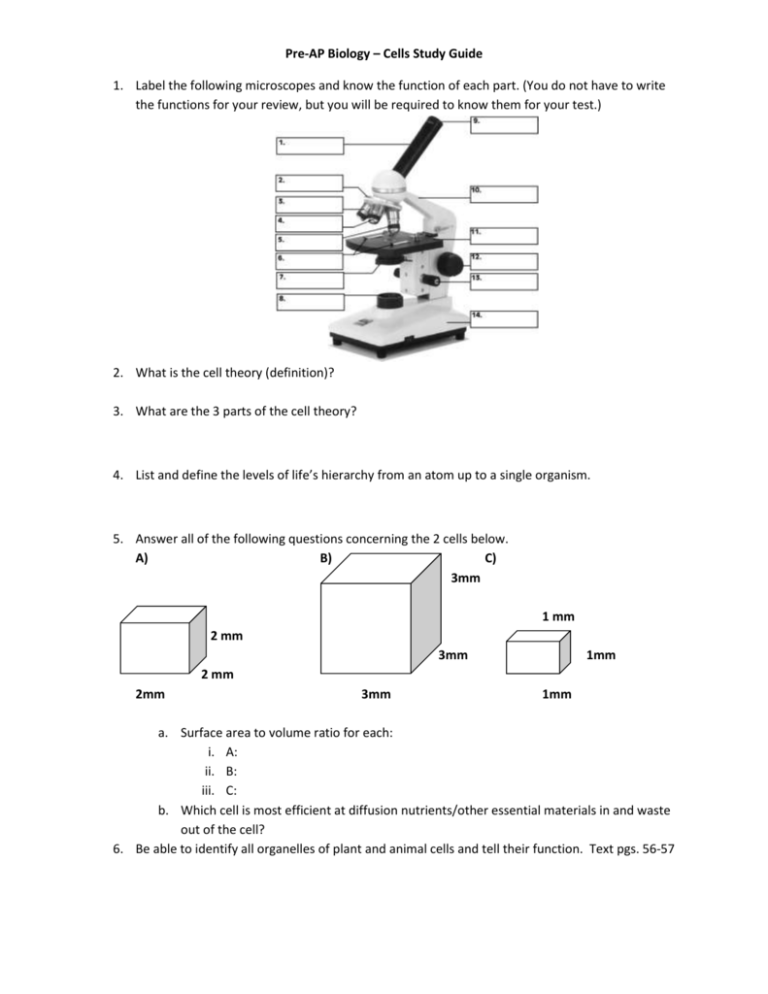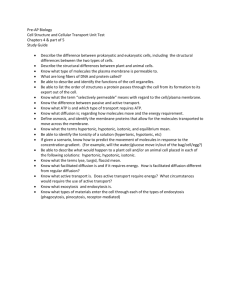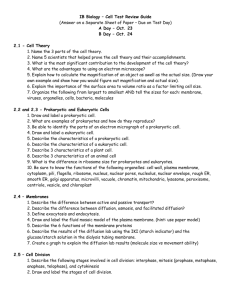10-6-15 Cells Study Guide
advertisement

Pre-AP Biology – Cells Study Guide 1. Label the following microscopes and know the function of each part. (You do not have to write the functions for your review, but you will be required to know them for your test.) 2. What is the cell theory (definition)? 3. What are the 3 parts of the cell theory? 4. List and define the levels of life’s hierarchy from an atom up to a single organism. 5. Answer all of the following questions concerning the 2 cells below. A) B) C) 3mm 1 mm 2 mm 3mm 1mm 2 mm 2mm 3mm 1mm a. Surface area to volume ratio for each: i. A: ii. B: iii. C: b. Which cell is most efficient at diffusion nutrients/other essential materials in and waste out of the cell? 6. Be able to identify all organelles of plant and animal cells and tell their function. Text pgs. 56-57 7. What are the functions of the following organelles? These are only some examples of what could be on the test. Question #6 tells you that you need to know them all, but this question is just to ensure that you studying this information. a. Lysosome b. Smooth and Rough ER c. Ribosomes d. Peroxisomes e. Nucleus f. Golgi Body g. Mitochondria h. Chloroplast 8. Be able to identify all the parts of a prokaryotic cell and tell their function (Text pg. 55). a. What are the only structures in the cytoplasm of a prokaryote? 9. What is the nucleolus? 10. What is a nucleoid region? What type of cell has a nucleoid region? 11. What are the 3 types of fiber that makes up the cytoskeleton? Which is the biggest and smallest? 12. Describe the functions of microfilaments & microtubules. Give an example of where each is found. 13. How are cilia and flagella different? 14. What type of cell would each of the organelles be most abundant: a. mitochondria b. Rough ER c. Smooth ER d. lysosome 15. What is the largest organelle in a plant cell? 16. Order cells from largest to smallest (animal, plant, bacteria) 17. List 3 differences between prokaryotic and eukaryotic cells. 18. What are 5 things that all cells must have (prokaryotic and eukaryotic) and why? 19. How is a cell wall different from a cell membrane (plasma membrane)? 20. What type of cell has a cell membrane (animal, plant, or prokaryotic)? 21. What type of cell has a cell wall (animal, plant, or prokaryotic)? 22. Does a plant cell have mitochondria? Why? 23. What is the function of a glycoprotein (found in the cell membrane)? 24. Where are ribosomes made? Where are they found? What do they make? 25. How does food within a food vacuole get digested? 26. What is apoptosis? 27. What are 3 organelles found in a plant cell and not an animal cell? 28. What are 2 structures found in animal cells not in plant cells? 29. Why does a plant wilt? 30. What is endosymbiosis? 31. List 3 pieces of evidence that supports endosymbiosis. Cell Membrane Structure and Transport Section 32. Define: a. Concentration – b. Concentration gradient – 33. What does the “fluid mosaic model” explain? 34. List 4 functions of proteins found in the cell membrane. 35. What do glycoproteins and glycolipids do, and why are they important to the immune system? 36. Define the following terms: a. permeable b. impermeable c. selectively permeable 37. Why do receptor proteins have a shape that fits a specific messenger? 38. How does a glucose molecule cross the cell membrane (Hint: glucose is large)? How about ions? 39. What is a “concentration gradient” and what is going “down or with” it and going “against it”? 40. What does tonicity refer to? 41. Explain the movement of water if a cell were placed in a… Hypertonic – Hypotonic – Isotonic – 42. What type of solutions do plant & animal cells prefer? 43. If an animal cell is placed in a hypotonic solution for too long, what will happen to it? What prevents a plant cell from doing this? 44. Define the following terms: a. flaccid b. lysis c. turgid d. plasmolysis 45. If solution A has a higher concentration of solute than solution B, what will move (solute or water) and which direction if diffusion is occurring? 46. If solution A has a higher concentration of solute than solution B, what will move (solute or water) and which direction if osmosis is occurring? 47. Using the diagram above, answer the following questions (answer by saying left or right): a. Which side is hypertonic? b. Which side is hypotonic? c. Which direction would diffusion occur? d. Which direction would osmosis occur? 48. List 2 differences between active & passive transport. 49. List and define the 3 examples of passive transport. 50. Give 2 similarities and 1 different between diffusion and facilitated diffusion. 51. Give 1 similarity and 2 differences between facilitated diffusion and active transport. 52. Answer the following questions about vesicular transport (also called bulk transport). a. Why do some molecules have to use vesicular transport (bulk transport – endocytosis and exocytosis) to enter or leave the cell? In other words, why can’t these materials move through the phospholipid bilayer or transport proteins like other solutes? b. This type of transport uses what to move materials into/out of the cell? c. Define endocytosis and exocytosis. d. Define the 2 different types of endocytosis. 53. A cell that has a concentration of 2 M is placed in the following solutions and the percent change in the mass of the cell was recorded. Use the chart to answer the following questions: Concentration of solution Percent change in mass (Molarity) 0 +23% 2 0% 4 -20% a. Which concentration is: a. hypertonic? b. isotonic? c. hypotonic? b. Explain why: a. the cell gained mass in the 0 M solution b. had no change in mass in the 2 M solution c. lost mass in the 4 M solution 54. Be sure to be able to identify and explain the functions of all of the components of the cell membrane. Use the diagram below.






